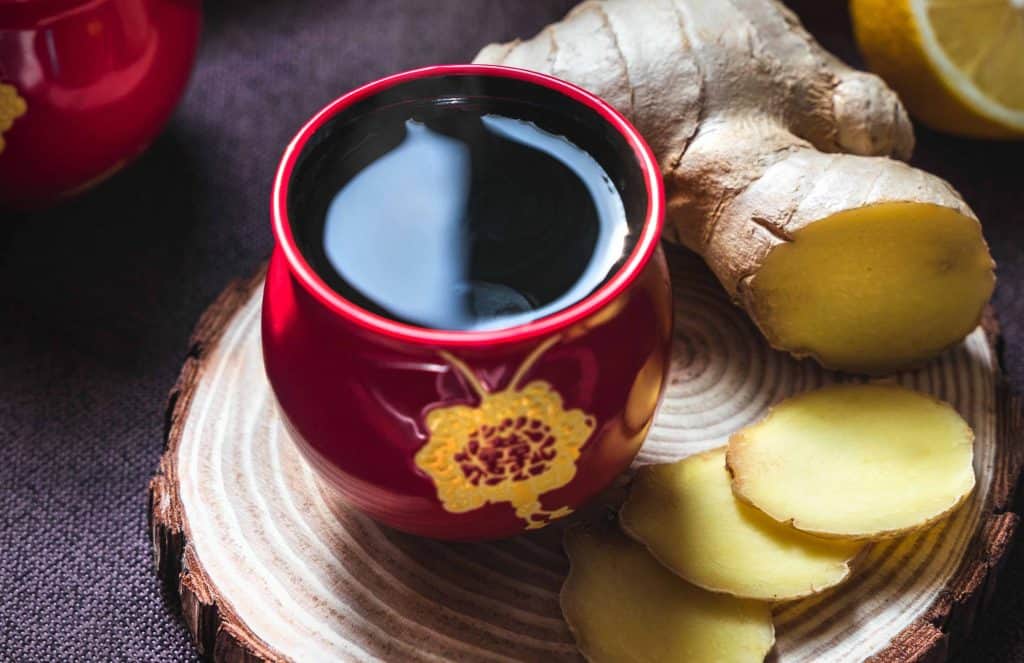
Ginger (Zingiber officinale) is a close relative to turmeric and galangal. If you met them all together at a function you could see the strong family resemblance – looking like a root, gnarly and jaundice. First cultivated in Southern India, ginger now flourishes commercially world-wide including Hawaii, Jamaica and Buderim, Queensland. Each ginger plant grows to a metre tall, with wide fleshy green leaves. The flower is an exotic spike of orange and red releasing a heady aroma. Although the flowers are used in some Asian delicacies, it is the less spectacular ginger root which is mostly used. The ginger root is actually a rhizome, the definition of which is ‘a stem that grows horizontally under the earth’.
As a herbalist, I am in love with ginger. Ginger is included in the materia medicas of all major herbal traditions, including Ayurveda, Arabic, European and Traditional Chinese Medicine. Recent scientific studies back up the hundreds of years of clinical evidence relating to the benefits of ginger. I take a thermos of hot water with some sliced ginger with me when I am in clinic or lecturing. Ginger is excellent for reducing nausea whether from travel, illness or pregnancy. Other benefits to the digestive system include relieving bloating, flatulence and cramping. I use ginger in many of my herbal teas, and it works particularly well in Digestivo, my blend for tummy troubles. Ginger has been shown to reduce blood stickiness and cholesterol, both risk factors for heart disease. It is also an effective anti-inflammatory, particularly useful for arthritis. Ginger is generally well tolerated, with the rare side effect, when taken to excess an inflamed gastric lining. Ginger also possesses a rare talent for a herb, it tastes good.
A versatile spice, ginger is used to flavour sweet and savoury dishes. It can be sliced, chopped, grated, juiced, minced, mashed or ground. Ginger is just as happy in curries and stir fries as in drinks, pickles, chutneys, sauces and cakes.
The reason why ginger is so adaptable is its mild pepper-like pungency that complements, rather than overpowers other flavours. This pungency comes from gingerols, chemically similar to chilli’s capsaicin and black pepper’s peperine. When ginger is dried, these chemicals jiggle an atom or two and are transformed into shagaols, which are darker and stronger tasting than the fresh version.
The Latin name, Zingiber, is derived from the Sanscrit, ‘Singebera’ meaning ‘horned’ or ‘with antlers’, a pretty good description of the branches of the large ginger rhizome. Pliny claimed ginger came from the fabled land of the Troglodytes. There may have been a cave-dwelling tribe of ginger growers, but it is more likely that the ginger came to Rome via trade routes through Egypt from India. In the 5th Century, Chinese vessels carried ginger growing in pots, eating small amounts of ginger at sea prevented the sailors from developing scurvy, a vitamin C deficiency, and the cause of thousands of deaths at sea. GInger was the most important spice in medieval Europe. Gingerbread, ginger beer and ginger ale all date from this time.
Ginger compresses, although fiddly, are fabulous for period cramps, muscle or joint pain. Into the middle of a chux or muslin cloth grate a cupful of ginger. Fold to form a ginger parcel. Place in a shallow bowl and pour over half a cup of boiling water. Leave until bearably hot. Gently squeeze and place on painful bit, wrap body part and parcel with plastic wrap. Wrap again in a towel, relax and keep warm for 20 minutes before unpeeling.